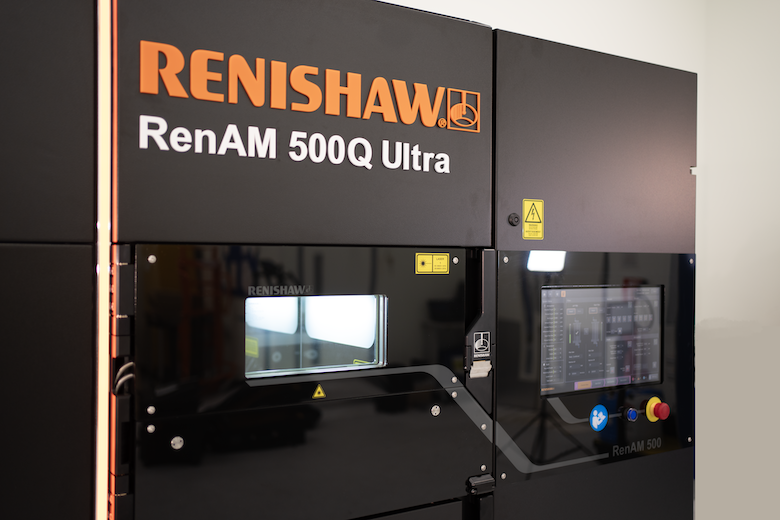Global engineering technologies company Renishaw unveiled TEMPUS technology and RenAM Ultra metal AM system at Formnext 2023.
Engineered to heighten productivity in additive manufacturing (AM) systems without compromising part quality, this technology introduces a novel scanning algorithm to Renishaw’s RenAM 500 series. Enabling laser operation during recoater motion, it promises substantial time and cost savings, potentially cutting build times by up to 50% across the entire cycle.
“Reducing cost per part is critical to the wider adoption AM technology,” said Louise Callanan, Director of Additive Manufacturing at Renishaw. “The dominant contributing factor to part cost for most components today is the time spent building the part on the machine itself. Reducing the amount of machine time per part therefore results in more cost-effective production.”

TEMPUS redefines laser productivity
TEMPUS technology optimizes additive manufacturing by allowing the laser to fire during recoater movement, saving up to nine seconds per layer. Synchronized with the recoater, lasers track its motion, melting powder seamlessly. This minimizes laser off-time per build, ensuring efficiency and substantial time/cost savings without compromising part quality.
Utilizing sophisticated scanning algorithms to sequence layer data, this technology maximizes productivity while upholding part quality. The extent of productivity gains may vary with part geometries, yet enhanced efficiency is achievable across all shapes. Particularly, parts featuring thin, vertical characteristics are anticipated to achieve more substantial productivity savings.
Integrated as standard in the new RenAM Ultra metal AM systems, Renishaw offers TEMPUS technology with quad or single laser configurations. RenAM 500 series users can upgrade to TEMPUS for enhanced productivity. Renishaw’s data suggests retrofitting TEMPUS to existing systems is comparable to adding an extra laser, optimizing overall machine investment.
“That’s why TEMPUS technology™ is such a big leap forward,” added Callanan. “Usually, the laser would turn off while the recoater is moving. Firing the laser while the recoater is moving minimises the laser off-time per build. The time and cost saving TEMPUS brings will open AM up to mass production applications where the technology would previously have been unviable.”
In an exclusive partnership with metal component expert Alloyed, Renishaw has also expanded the use of TEMPUS technology in consumer electronics and computing since 2021.
Unleashing efficiency with RenAM 500 Ultra
Renishaw is expanding its RenAM 500 series with the Formnext debut of the RenAM 500 Ultra AM system. Retaining the series’ benefits, this system incorporates industry-leading design with newly-introduced TEMPUS technology and advanced process monitoring software, enhancing productivity. The software provides detailed insights, equipping users with real-time visibility during the build. Empowering metal additive manufacturing users, this comprehensive system accelerates part production efficiently and represents a significant advancement in the field.
The RenAM 500 Ultra metal AM system stands as the newest addition to the RenAM 500 family, joining the Flex system, tailored for R&D work, and the flagship closed-loop powder recirculation model designed for series production. Within the RenAM 500 family, both the 500S and 500Q models offer the flexibility of one or four high-powered lasers, capable of simultaneously covering the entire powder bed. Both the RenAM 500Q Ultra and RenAM 500S Ultra models are currently available for order.
“The RenAM 500 Ultra system produces exactly the same high part quality you expect from the rest of the RenAM 500 series, but twice as fast,” added Callanan. “We’re excited to bring this new model to market as we believe that increasing productivity and lowering cost per part will facilitate wider industry adoption of AM.”
Major advances in metal 3D printing
Chinese 3D printer manufacturer Eplus3D introduced the EP-M1550, the largest Metal Powder Bed Fusion (MPBF) system. Its notable 16-laser setup enables handling large build platforms, offering cost-effective production of sizable parts. Expandable to 25 lasers, the design employs a 4×4 laser and galvanometer matrix, ensuring synchronous operation with a remarkable build rate of up to 650 cm³/h. With a focus on large-scale production, it provides a generous build volume of 1558 x 1558 x 1200 mm, extendable to 2000 mm in height, supporting diverse materials for aerospace applications.
Farsoon Technologies unveiled its FS1521M Laser Beam Powder Bed Fusion (PBF-LB) 3D printer series with 16 fiber lasers. Featuring a 1530mm build chamber diameter and 850mm Z-axis height, the FS1521M ensures substantial capabilities. Its variant, FS1521M-U, offers an increased Z-axis height of 1650mm. Both models boast 16 500-watt fiber lasers, enhancing productivity for large-scale 3D printing. Revealed at TCT Asia 2023, Farsoon positions its metal 3D printers as promising solutions for industries like oil & gas and aerospace, showcasing advanced technology.
Read all the 3D Printing Industry coverage from Formnext 2023.
Voting has now started for the 3D Printing Industry Awards 2023. Cast your vote now!
What does the future of 3D printing for the next ten years hold?
What engineering challenges will need to be tackled in the additive manufacturing sector in the coming decade?
To stay up to date with the latest 3D printing news, don’t forget to subscribe to the 3D Printing Industry newsletter or follow us on Twitter, or like our page on Facebook.
While you’re here, why not subscribe to our Youtube channel? Featuring discussion, debriefs, video shorts, and webinar replays.
Are you looking for a job in the additive manufacturing industry? Visit 3D Printing Jobs for a selection of roles in the industry.
Featured image shows Renishaw has expanded its RenAM 500 series with the RenAM 500 Ultra. Photo via Renishaw.


